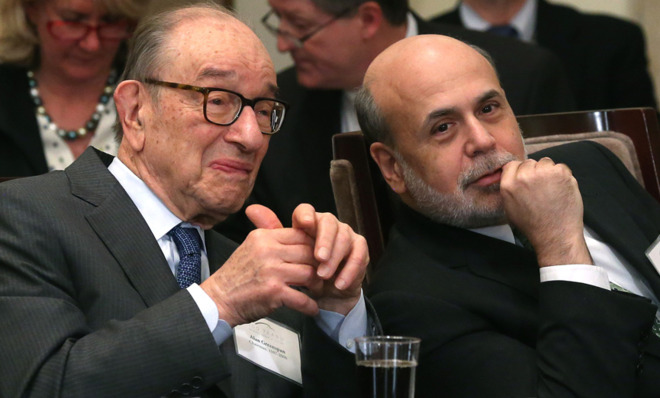Does the United States need a sovereign wealth fund?
The government could use the fund to offset the effects of a financial crash

Last week, I explained why occasional financial crashes are unavoidable.
The world is extremely unpredictable, and out-of-the-blue events can radically alter the course of history. This means that identifying bubbles is extremely difficult, and that bursting potential bubbles through policy is dangerous — indeed, it arguably led to the Great Depression.
Furthermore, markets respond to stability by becoming more risk-tolerant, as occurred in the run-up to the 2008 crash.
The Week
Escape your echo chamber. Get the facts behind the news, plus analysis from multiple perspectives.

Sign up for The Week's Free Newsletters
From our morning news briefing to a weekly Good News Newsletter, get the best of The Week delivered directly to your inbox.
From our morning news briefing to a weekly Good News Newsletter, get the best of The Week delivered directly to your inbox.
This means that policymakers are largely limited to dealing with reducing the fallout from the business cycle — maintaining low unemployment and low inflation, as well as avoiding crises like bank runs, deflationary spirals, and systemic breakdowns.
Two economics professors, Miles Kimball of the University of Michigan and Roger Farmer of UCLA, disagreed with my argument that financial crashes are necessarily unavoidable, and recommended I look into the creation of a sovereign wealth fund for the United States as an economic stabilization mechanism.
Sovereign wealth funds are large investment companies owned by governments that manage an array of financial assets, from stocks and bonds, to income from natural resources and real estate. In order of holdings, the Monitor Group’s Sovereign Wealth Fund Assets Under Management Table shows that Norway, China, United Arab Emirates, Singapore, and Kuwait have the largest sovereign wealth funds.
Why would the United States want one? Kimball explains :
A free daily email with the biggest news stories of the day – and the best features from TheWeek.com
Establishing a U.S. sovereign wealth fund to do the purchasing of long-term and risky assets would give the Fed room to maneuver in monetary policy, and restrict its job to steering the economy rather than making controversial portfolio investment decisions. And a U.S. sovereign wealth fund could stand as a bulwark against wild swings in financial markets. [Confessions of a Supply Side Liberal]
Kimball and Farmer argue that a sovereign wealth fund can reduce financial instability through countercyclical investment policies. For example, if the stock market and economy are overheating, then the sovereign wealth fund can sell stocks to calm the mania. If unemployment is too high, then the sovereign wealth fund can invest in companies to spur growth and hiring.
I still don’t think that this kind of mechanism can prevent financial crashes altogether. But in terms of managing a crash and limiting its downside, it is not unreasonable to think that a sovereign wealth fund would be a helpful tool.
The closest any nation has come to using such a fund in this fashion is Chile. Chile's sovereign wealth fund — established from the proceeds of copper mining — is designed to fund government stimulus spending during an economic downturn, which it did after the global economic slump in 2008. Chile emerged from the slump with very strong growth.
But where would the money come from in the U.S.? Well, Social Security and Medicare have $3 trillion invested in government debt that could be used to start such a fund, and the U.S. government collects billions in oil royalties each year.
But this immediately brings us to the first problem: Would such a fund be expected to make a profit, or invest in a countercyclical manner? The two aims may sometimes be contradictory. If stocks are going up, the most profitable thing to do is buy, buy, buy. The countercyclical thing to do is to sell, to take the heat off the market. But that may incur losses, and if you’re managing a large amount of public money, then it is difficult to justify incurring a taxpayer loss in the name of financial stability.
Second, there may be a problem of overlap with existing agencies. The Federal Reserve already monitors financial system stability, and engages in monetary policy with the aim of generating stable inflation and a low unemployment rate. The Fed can already buy assets with the aim of stimulating the economy, or taking the heat off a boom. Would the sovereign wealth fund coordinate with the Fed to verify that they’re both pulling in the same direction? Would the two agencies be run by different people with different mandates who might disagree with each other? And does the Fed not have a key advantage in that it is never expected to make a profit?
Third, there is the danger that the fund might become a tool of cronyism by investing in politically connected assets and projects. Fund managers would need paying, too, which could again could result in cronyism. And who pays if the money managers screw up and lose a lot of money? Ultimately, the taxpayer.
Still, this idea is definitely worthy of further exploration. It could certainly be beneficial to have a large fund that could act in a countercyclical manner — investing when the economy is in the dumps, and divesting when the economy is overheating — as a check against booms and busts.
The Chilean example shows that it is possible.
John Aziz is the economics and business correspondent at TheWeek.com. He is also an associate editor at Pieria.co.uk. Previously his work has appeared on Business Insider, Zero Hedge, and Noahpinion.
-
 ‘It is their greed and the pollution from their products that hurt consumers’
‘It is their greed and the pollution from their products that hurt consumers’Instant Opinion Opinion, comment and editorials of the day
-
 Jane Austen lives on at these timeless hotels
Jane Austen lives on at these timeless hotelsThe Week Recommends Here’s where to celebrate the writing legend’s 250th birthday
-
 ‘Mexico: A 500-Year History’ by Paul Gillingham and ‘When Caesar Was King: How Sid Caesar Reinvented American Comedy’ by David Margolick
‘Mexico: A 500-Year History’ by Paul Gillingham and ‘When Caesar Was King: How Sid Caesar Reinvented American Comedy’ by David Margolickfeature A chronicle of Mexico’s shifts in power and how Sid Caesar shaped the early days of television